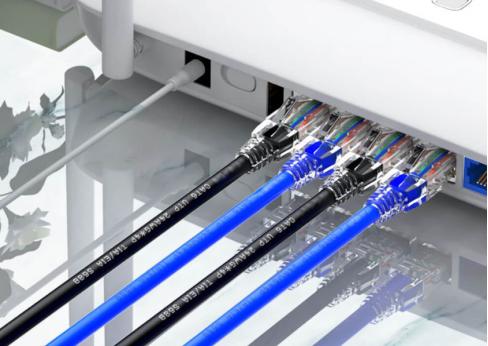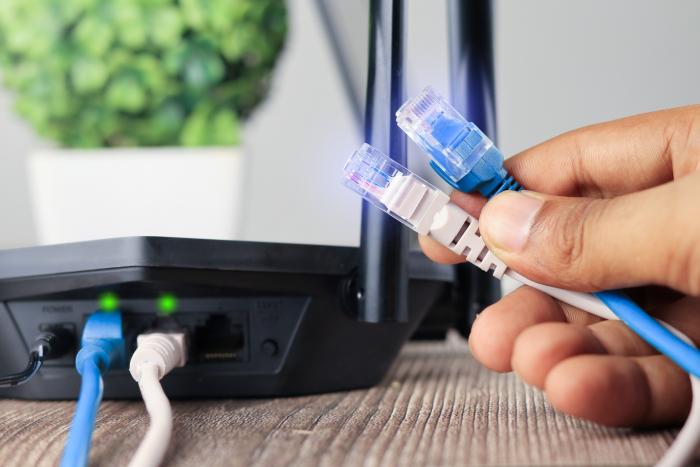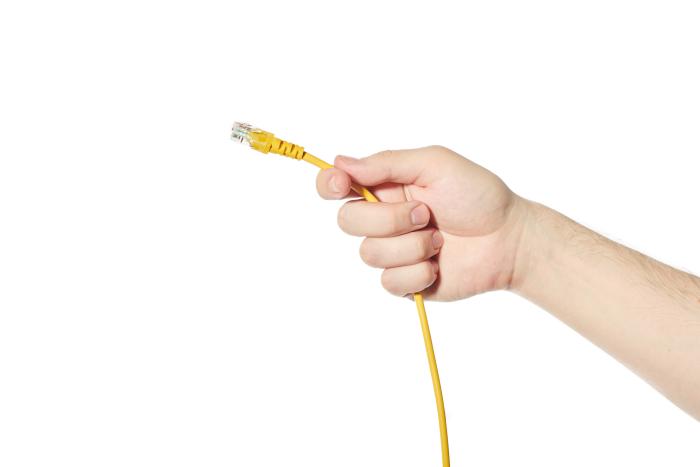An Overview of Ethernet Patch Cable

When you start to build a wired network, there are some basic terms you should know.
What is Ethernet Cable
“Ethernet” is a type of protocol that defines the way that bits of information travel over a particular medium. The cables such as fiber optic cable, twisted pair or coaxial cable and category cable belong to Ethernet cable. The two common types of Ethernet cable are copper network cable and fiber optic cable. Ethernet cables are available in shielded or unshielded versions. Usually, to simplify the appellation, people get used to call category Ethernet cables like Cat5, Cat5e and Cat6 as Ethernet cable.
Ethernet cables have different specifications and use cases depending on the cable type. Optical fiber cables are well-suited for long-haul connections over distances of hundreds of meters or more. Their use of light signals rather than electricity also makes them preferable when high bandwidth or electrical isolation is required. In contrast, Ethernet crossover cables are used in buildings. Meanwhile, twisted pair copper cables like Cat5e and Cat6 are also commonly run within buildings to interconnect devices on the local area network.
What is a Patch Ethernet Cable
The patch Ethernet cable sometimes also called Ethernet patch cord, is a length of cable with connectors on both ends that are used to connect devices: an end device to something else like a power source. Similar to Ethernet cables, there are fiber patch cables and Ethernet patch cables like cat5e patch cables or cat6 patch cables.
Patch cables are often used for short distances in offices and wiring closets and support transmission speeds ranging from 5 gigabits per second up to 10 gigabits per second. The maximum bandwidth is determined by adhering to standards set by IEEE networking protocols.
Ethernet patch cable can link a computer to a network hub, router or Ethernet switch, which is useful to people constructing home computer networks.
Therefore, in simple terms, Ethernet cable refers to types of cable. While patch cable is used to connect two devices and belongs to a part of the Ethernet cable. That’s the difference between them.
Ethernet Patch Cable VS Structured Cabling
While Ethernet patch cables and structured cabling both play crucial roles in creating a network, there are some key differences between the two. Patch cables are shorter, flexible cables designed for connecting devices to a network. They usually have connectors at both ends, making them highly versatile and easy to use.
Structured cabling, on the other hand, refers to a more comprehensive and organized system of cables, hardware, and other components. It forms the backbone of network infrastructures like LANs and data centers. Structured cabling often consists of longer runs of cable, connecting patch panels, switches, and other network hardware.
To summarize, Ethernet patch cables are ideal for individual device connections within a network, while structured cabling forms the foundation and structure for larger, more extensive networks.
Patch Cable Connectors

When dealing with patch Ethernet cables, it’s essential to familiarize yourself with the different types of connectors typically found on these cables. In this section, we’ll explore some common connectors, including RJ-45, RCA, XLR, BNC, 8p8c (RJ-45) modular connectors, and Banana connectors.
RJ45 Connectors
RJ45 connectors have become ubiquitous in Ethernet networking due to their modular and gendered design. The plugs and jacks that comprise the RJ45 system allow for easy reconfiguration of work areas and replacement of network devices.
With their resemblance to telephone jacks but slightly larger size accommodating eight pins, RJ45 connectors are likely the most prevalent interface you’ll see on Ethernet patch cables. Their compatibility across device types makes them perfect for establishing wired connections in local area networks. Computers, routers, switches, and other LAN gear can all be quickly linked together using standard RJ45 plugs.
RCA Connectors
RCA connectors, also known as phono connectors or cinch connectors, are primarily used for transmitting audio and video signals. Although not as common as RJ-45 connectors in the Ethernet world, RCA connectors can occasionally be found on patch cables for audio-visual equipment or specialized networking setups.
XLR Connectors
XLR connectors are renowned for their durability and ability to provide secure connections in professional audio, video, and lighting applications. You might encounter XLR connectors on patch cables used for microphones, mixers, speakers, and more. Although uncommon for Ethernet cables, XLR connectors may still be applicable in specific network scenarios.
BNC Connector
BNC stands for Bayonet Neill–Concelman, a type of connector that is predominantly used for coaxial cables. BNC connectors are often employed in radio, television, and other specialized network applications, offering a secure and robust connection. Like XLR connectors, BNC connectors are not typically found on Ethernet patch cables but may be relevant in some network situations.
8p8c (RJ-45) Modular Connectors
8p8c connectors, often mistakenly referred to as RJ-45 connectors, are modular connectors commonly used for Ethernet patch cables. The term “8p8c” represents the eight positions and eight available contact slots within the connector. In essence, 8p8c connectors are virtually identical to RJ-45 connectors, and the two terms are frequently used interchangeably.
Banana Connectors
Banana connectors are single-wire connectors mainly used for connecting speakers to amplifiers or other audio equipment. These connectors have a distinct banana-like shape, which is where their name comes from. While banana connectors are not commonly associated with Ethernet patch cables, they can still be relevant in specific scenarios involving audio setups or custom networking requirements.
In summary, these are just a few of the many connectors you might encounter when working with patch Ethernet cables. Familiarizing yourself with these connectors will help you better understand how patch cables integrate various devices within your network.
Patch Cables in Networking
In this friendly guide, we will discuss how patch cables are used in networking with a specific focus on patch panels, switches, and routers.
Patch Panels
A patch panel is a device that helps organize and manage the cables in your network. It serves as a central connection point for incoming and outgoing cables. By using patch panels, you can simplify cable management and troubleshooting. To connect your devices, simply plug the patch cables into the appropriate ports on the patch panel. This way, it’s easier to identify and fix any issues that may arise with your network connections.
Switches
Switches play a crucial role in your network by directing the flow of data between connected devices. When you plug a patch cable into a switch, it establishes a connection to the device at the other end of the cable. This allows devices within your network to communicate with one another effectively. For example, if you have multiple computers and a printer, connecting them to a switch using patch cables will enable you to share files and print documents without any hiccups.
Routers
Routers are essential in connecting your local area network (LAN) to the Internet. They allow you to share your Internet connection with all devices on your network. To set up your router, connect it to your modem using a patch cable. This cable will carry the Internet signal from the modem to the router. Next, use additional patch cables to connect the router to your devices or your network switch if you’re using one. Once everything is properly connected, you can enjoy a seamless Internet connection on all your devices within the network.
Patch Cable Usage Scenarios

Home Use
In a home setting, an Ethernet patch cable can significantly improve your network experience. These cables are often used to connect various devices to your home network, such as gaming consoles, computers, and routers. By using patch cables, you can achieve faster and more reliable connections compared to Wi-Fi, especially in situations where Wi-Fi signals may be weak or congested. This can greatly enhance your online gaming, streaming, and other internet activities.
Corporate Offices
Ethernet patch cables also play a crucial role in corporate offices. They are frequently used to connect workstations, printers, servers, and other network devices. In an office environment, the use of patch cables can help create a more organized and efficient network infrastructure. By providing a high-quality connection between devices, they can facilitate seamless communication and data transfer, contributing to increased productivity and reduced downtime.
Some benefits of using Ethernet patch cables in an office setting include:
- Reliability: Patch cables offer a more stable and reliable connection compared to wireless networks, reducing the risk of connectivity issues.
- Network Performance: By bypassing Wi-Fi and directly connecting devices to the network, patch cables can help boost network speeds and performance.
- Security: Wired connections are generally more secure than wireless connections, making patch cables a safer choice for protecting sensitive data in a corporate setting.
Remember to choose the appropriate patch cable type, such as Cat5e, Cat6, or Cat6A, based on your network requirements and the devices you want to connect. This way, you can ensure that your home or office network operates at its full potential. Overall, Ethernet patch cables offer a versatile solution for connecting devices and improving network performance in various scenarios.
Special Types of Cable
In this section, we will cover some specific types of Ethernet patch cables that you might come across. These include snake cables, pigtails, and blunt patch cords. Each has its unique purpose and application.
Snake Cables
Snake cables are thick, hose-like cords that are often used to carry video or amplified signals. They’re designed to bundle multiple cables together, which makes it easier to manage cabling in a larger setup, like a live performance or a video production environment. When using Ethernet-style snake cables, you essentially consolidate multiple patch cords into a single assembly, making cable management more organized and efficient.
Pigtails
Pigtails refer to short cords or cables that have a connector on one end and exposed wires on the other. In the context of Ethernet patch cables, pigtails are used to join two cables or devices, such as connecting an Ethernet cable to a punch-down block or other terminal equipment. The exposed wires can be connected to a receptacle or terminal via methods like soldering, crimping, or wire wrapping. Pigtails are helpful in customizing cable lengths, creating unique cable configurations or joining cables with different connector types.
Blunt Patch Cords
Blunt patch cords are Ethernet patch cables with the connectors removed or ones that haven’t been terminated. While they may look unfinished, they can be useful in certain situations. For example, you might use a blunt patch cord to install a custom connector tailored to your requirements or to pass a cable through a tight space where a traditional connector wouldn’t fit. In such cases, you’ll terminate the cable yourself after it has been routed through the desired location, giving you more flexibility in cable installations.
Frequently Asked Questions
What is Ethernet Cable Categories
Cat5 and Cat5e are the most common ethernet patch cables used in home and office networks. Cat5 cables can handle up to 100 Mbps at 100 meters, while Cat5e cables, an enhanced version of Cat5, support up to 1000 Mbps (Gigabit Ethernet) at the same distance. Cat5e cables have tighter twists in the wire pairs to improve signal quality and reduce interference. You might consider using Cat5e cables for basic networking needs and economy.
Cat6 network cables are the next step up in performance. With faster data transmission speeds (up to 10 Gbps), these cables are suitable for more demanding environments. They also have a reduced maximum distance of 55 meters (for 10 Gbps data rates) compared to Cat5e. The main feature of Cat6 cables is better insertion loss, return loss, and crosstalk over Cat5e, providing a more reliable connection. It’s a great choice if you need a higher-performing network at a reasonable price.
Cat6a cables build on the success of Cat6 cables with added improvements. Cat6a cables support 10 Gbps data rates at distances up to 100 meters, with even better signal integrity and reduced crosstalk. They are thicker and shielded to minimize electromagnetic interference, allowing for higher performance. If you require faster, reliable connections over greater distances in your network, Cat6a is an excellent investment.
Lastly, Cat8 cables are the latest in ethernet cabling technology, offering significant performance improvements. Capable of handling up to 25-40 Gbps at distances up to 30 meters, Cat8 cables are designed for short-range, high-speed applications in data centers and enterprise networks. Their increased shielding ensures optimal signal quality and faster data transmission times, albeit at a higher cost than other categories.
Is Patch Cable a Straight-through Cable?
Standard Ethernet patch cords are straight-through wired for simplicity. Crossover patch cables have a niche purpose in directly connecting identical hardware only. Patch cables provide reliable, straightforward connectivity in day-to-day networking tasks.
How Many Types of Patch Ethernet Cable
Copper patch cables are the most common type of Ethernet patch cables you will encounter. They are made from copper wires and come in various categories. These cables provide reliable connectivity for your networking needs, whether it’s in a home or office environment. Copper patch cables are widely used due to their affordability, ease of use, and compatibility with various devices.
Fiber optic patch cables are another option for your Ethernet connection needs. These cables use thin strands of glass or plastic to transmit data as pulses of light, which allows for faster data transfer rates and longer distance connections compared to copper cables. Fiber optic patch cables come in two main types: single-mode and multi-mode. Single-mode fiber cables are designed for longer distances and higher speeds, while multi-mode cables cater to shorter distances and lower speeds. If you require high-speed connectivity and your network infrastructure supports fiber optics, these cables might be the ideal choice for you.
Coaxial patch cables are less common for Ethernet connections, but they still serve a purpose in specific situations. These cables consist of an inner conductor surrounded by a dielectric insulator, which is enclosed by a conductive shielding layer and an outer protective jacket.
